
Fully updated and republished in August 2016.
This week, the start of August 2016, marks the eight year mark since I left my day job.
Ever since then, I’ve been supporting myself through writing. It’s my dream career – and I love being able to set my own hours, work from home, and have a huge amount of flexibility and freedom.
In the past four years, I’ve been particularly glad of my career: I now have two young children, and I’ve been able to spend a lot of time with them while continuing to do what I love for a living.
I haven’t written much here on Aliventures about how exactly I actually make money. Maybe you suspect that there’s some amazing secret skill involved, or some sort of dark art.
But there really isn’t. Turning words into money might sound like spinning straw into gold … but it’s a darn sight easier.
And … if you want to … there’s no reason why you can’t do exactly the same as me.
In short, over the past eight years, I’ve had a bunch of different revenue streams: some for a year or two, some for the whole time. I’m going to explain the basics of each, and provide some links to places where you can get further information or try these methods out for yourself.
I’ll start with the ones that were easiest to get going with, and work up to the methods that take a bit more time.
Note: for each method, I’ve indicated when I did it and, if I stopped, I’ve noted why.
#1: Paid Writing for Blogs (2008 onwards)

(One of my early posts on DailyWritingTips – you can read it here.)
This is how I started out, in early 2008. My first ever paid position was with Diet Blog (thanks Jim!) and my second one was with Daily Writing Tips (thanks Daniel!)
At first, my family and friends found it quite weird that I could get paid to write for blogs, and even eight years on, people are still sometimes surprised that paid blogging exists. It’s no big mystery, though. Like magazine and newspapers, blogs need regular content. Many generate revenue through advertising, and they need a constant stream of new articles to bring in readers.
Writing for blogs typically means:
- Regular work – often writing one or more posts every week
- Flexibility over what you write about – most of the time, I’ve chosen my own topics
- Quick payments, usually via PayPal
- The chance to get your work in front of tens of thousands of people
How Much Does Paid Blogging Make?
I’ve been paid anything from $20 – $300 per post, depending on the length and complexity. Around $50 for a 750 word post is a decent rate.
Magazines often pay more per word – but they’ll also have longer turn-arounds, and higher requirements.
These days, when I write paid blog posts, I usually make $70/hour. (Including admin time.) I write fast! This is also my current standard hourly rate for any freelance writing.
Learn More:
Make Money Blogging, Darren Rowse, ProBlogger – if you’re new to blogging, start here. Although this post is aimed at bloggers looking to make money from their own sites, there are loads of links to great information about writing great blog posts and building engagement (both important when you’re undertaking paid blogging).
Earn Money Online: 92 Websites That Pay Writers $50+, Jennifer Roland, Make a Living Writing – this is a great place to begin when you’re looking for well-paid blogging work.
The Blogger’s Guide to Freelancing – I’ve written a whole ebook about making money as a paid blogger. It’ll teach you everything I’ve learnt in my years of writing for blogs. (Note: this one’s on my schedule for an update and some extra bonuses in late 2016 or early 2017: if you buy now, you’ll get the update when it comes out at no extra charge … even if I raise the price.)
#2: Website Advertising (2008 onwards)
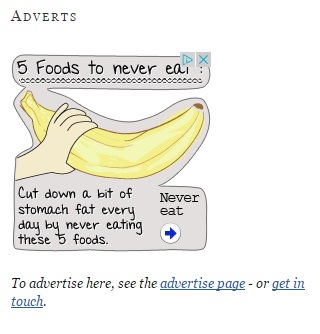
(An ad on my first blog, The Office Diet.)
In November 2008, I got my very first Google Adsense cheque, for a whopping $100 or so. Nowadays, most of my advertising income is from people who pay to have a link or banner ad up on my site.
As of November 2015, I no longer run any advertising here on Aliventures. These days, all my advertising revenue is from a couple of dormant blogs: The Office Diet and Alpha Student. I wrote a lot of content for those sites seven+ years ago, and I’m still reaping the benefits every month.
If you’re selling text links as adverts, do be careful with this: Google states you should “no-follow” these links (so they don’t boost the advertisers’ Google ranking) and you could find your blog dropping way down Google’s search engine results if you don’t obey their rules.
Do keep in mind that advertising may not combine well with other strategies for making money. For instance, if you sell high-end services, you won’t want to put prospective clients off with lots of garish ads.
How Much Do Ads Make?
This varies hugely depending on how big your site is. Unless you have a lot of traffic to your site, you’ll probably want to combine this with other methods.
Advertising is a long-term strategy. It took me eleven months to get that first Google Adsense cheque – but since then, the time that I invested on writing content has really paid off. If you’re a fast writer, and if you’re willing to put in the work to build a popular website, then you may well be able to make good advertising revenue.
Learn More:
Google AdSense – this is a good place to start, though as your site grows, you’ll want to look at approaching advertisers direct.
6 Ways to Make Money with Advertising on Your Blog and the Websites to Help You, Jeff Bullas, JeffBullas.com – this detailed post explains the key types of advertising that you could try, and gives links to loads of ad networks and other companies that can help you get started with each of them.
13 Reasons Why Blog Ads Are a Silly Monetization Strategy (And What to Do Instead), Sarah Peterson, SmartBlogger – ads aren’t right for every blogger or every blog, and there are some good reasons to think twice about using them … which this post explores.
#3: Affiliate Promotions (2009 onwards)
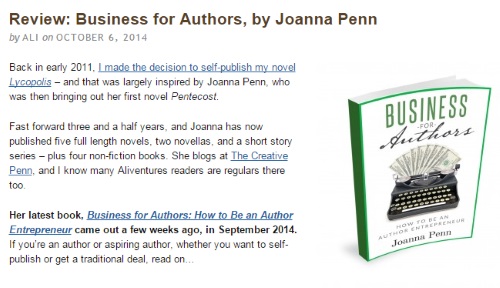
(From my review of Joanna Penn’s Business for Authors.)
A small proportion of my income comes from affiliate sales. When I write a review of a product, I normally link to it with a special URL that lets me get commission on any sales that I make.
This is one of my smallest revenue streams, largely because I don’t review books and products all that often, and I don’t like to be pushy about them.Whenever I use an affiliate link, it’s for a product that I own and that I like – I’ll only promote things that I’m happy to be associated with.
If you’re in the US, note that you are required by law to clearly disclose affiliate links or relationships to your readers: Amy Lynn Andrews has an in-depth post on that here.
How Much Do Affiliate Promotions Make?
On independently sold ebooks (ie. not through Amazon or other retailers) and other digital products, many authors/creators will pay 50% commission. With products on Amazon, you’ll normally get 5-6% commission.
Obviously, you’re more likely to make sales if (a) you have a big audience and (b) the book or product is very on-topic for your audience.
Learn More:
The Ultimate Guide to Making Money with the Amazon Affiliate Program, Darren Rowse, ProBlogger– an in-depth post on ProBlogger about Amazon specifically, but with plenty of advice that applies to any affiliate endeavours
Blogger’s Guides affiliate program – my own affiliate program, if you’re interested in spreading the word about my Blogger’s Guides. It has step-by-step instructions to get you started.
7 Simple Ways to Make More Affiliate Income from Your Blog, Ramsay, Blog Tyrant – a detailed post helping you go further as an affiliate, though it starts off with a beginner-friendly introduction to affiliate marketing.
#4: Coaching (2010 – 2012)
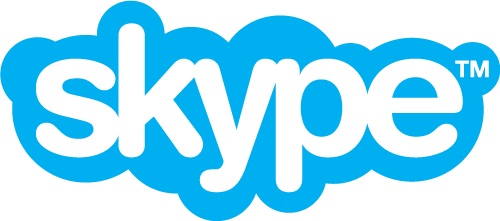
For a long time, coaching wasn’t on my radar. But after I was asked if I offered mentoring, and after several friends had turned to me for help with blog posts or sales pages, I realised that there was definitely a demand out there for writing coaching.
All through my teens and my twenties, I’d been involved in workshops with other writers, so I’m used to giving feedback and I know what sorts of issues to watch out for. I also really enjoy working with people on their writing, so it was quickly obvious that coaching was a good fit! I’ve also got a degree in English and a Masters in Creative Writing, which means that I usually know what I’m talking about…
I started out by working with a few people for free, until I was confident in charging for my coaching, then worked one-on-one with paying clients over Skype. Almost every client I worked with booked multiple sessions.
(If you want to do something similar, note that you can use Skype to call landlines and mobiles. This is much cheaper for international calls than using your phone!)
Although I loved coaching, there were a couple of key reasons why I stopped offering it in 2012:
- I was pregnant with my daughter Kitty (now a great big three year old), and I guessed (rightly!) that once she came along, it would be tricky to schedule a lot of calls around her.
- Many of the writers I wanted to help – those near the start of their writing career – simply couldn’t afford my coaching rate.
How Much Does Coaching Make?
I started at $79 for an hour-long session, then charged $79 for an 45 minute coaching session. I usually spent around half an hour preparing for each session in advance, reading the client’s work.
The price of coaching can vary enormously, and my prices were definitely on the low end. I’ve seen some business coaches charge $500/hour or more. If you’ve got expertise in a particular area of writing or publishing, coaching can be a great way to bring in a solid income with just a handful of clients.
Learn More:
Coach the Life Coach – a blog from Tim Brownson with lots of great advice on life coaching (though much of this would be helpful for any sort of coaching you might think about offering)
What Does a Writing Coach Do, Anyway?, Charlotte Rains Dixon, Words Trumpet – this post sets out some different ways in which coaches or teachers work with writers, which may help you narrow down what you want to offer as a coach.
Which Coaching Model Makes More Money?, Naomi Dunford, IttyBiz – here, Naomi takes a look at different coaching models, including one-on-one, and explains some of the pros and cons of each.
#5: Ebook Sales (2009 onwards)

(The Blogger’s Guides.)
I make considerably more money selling my own ebooks than promoting other people’s. Back in 2008, I brought out my very first paid ebook (it was okay, all things considered) and since then, I’ve created several more. The ones that have sold best are my four (so far!) Blogger’s Guides:
- The Blogger’s Guide to Freelancing
- The Blogger’s Guide to Effective Writing
- The Blogger’s Guide to Irresistible Ebooks
- The Blogger’s Guide to Loyal Readers
I really enjoy writing ebooks, because they give me a chance to work on an extended project (the Blogger’s Guides are all over 20,000 words long) and because they’re affordable for people who might not be able to pay for my coaching or for an ecourse.
How Much Do Ebooks Make?
If you’re writing business-related ebooks (rather than novels or popular non-fiction) then you can charge almost any amount that your audience will pay. A few years ago, it wasn’t uncommon to find ebooks that cost $97 or even more.
These days, with the rise in popularity of e-readers like the Kindle, people are getting used to cheap ebooks. You can still position yours as a premium product, especially if it contains specialist information and includes bonuses like audio interviews or video tutorials. Anything from $10 – $50 could work, depending on your topic and the length of your ebook.
Alternatively, you could create a much cheaper ebook aimed at a wide audience and sell it through Amazon (and potentially other ebook stores).
As to how many you’ll sell … that depends on how large and responsive your audience is. I sometimes guest post on much bigger blogs (like ProBlogger, Write to Done and The Write Life) to get my ebooks in front of more people.
Learn More:
21 Dumb Mistakes to Avoid When Writing Your First E-book, Ali Luke, SmartBlogger – this post of mine went down really well on SmartBlogger (formerly Boost Blog Traffic), and is packed with advice on what to avoid and what to do instead. Even if you’re only creating a short, free ebook – perhaps as an opt-in incentive for your email list – give this one a read.
The Blogger’s Guide to Irresistible Ebooks – this will teach you about creating and selling a premium ebook. Note: it’s on my schedule for an update plus some bonus goodies in late 2016 – early 2017; if you buy it now, you’ll get the updated version free even if I increase the price.
e-junkie – this is the site that I used for my ebooks from 2008 – 2014. It hosts the files, provides an affiliate program so people can sign up as affiliates for your ebooks, keeps track of sales, and so on. It’s very cheap, starting at just $5/month.
PayHip – this is the site I now use for my ebooks (after they were off the market for most of 2015). I was perfectly happy with e-junkie, but changes in EU law meant that I needed to pay VAT on ebook sales: PayHip handles this for me and e-junkie doesn’t!
#6: Running Ecourses (2011 onwards)

(On Track was my first ecourse, and is now available at no extra charge to members of Writers’ Huddle.)
When I started out with ecourses, I first ran them through email, then through a membership site where members could login for the latest modules. (I prefer the membership site route, because it means that if I add or update course materials, everyone has access to the latest versions – including members who took the course a year or two before.)
Over the past couple of years, it’s been tricky for me to launch and administer e-courses (due to very small children in the house!) Currently, my ecourses are only available to members of Writers’ Huddle, but I hope to offer them to non-Huddle members next year (2017). Stay tuned for more on that.
I’ve also created and co-run ecourses with Daily Writing Tips and Daily Blog Tips. Along the way, I’ve found that:
- Ecourses are a great way to have some small-group interaction with people who don’t want or can’t afford one-to-one coaching.
- They’re incredibly fun – I get to see members cheering one another on, conquering new challenges, and so on.
- When I run courses live, with a group, they take up a lot of energy and time. It’s not just a case of writing the materials – I’m showing up to answer questions, to encourage people and so on. There’s also a lot more admin involved.
- With membership site software (I use Digital Access Pass), it’s easy to set up an ecourse to run automatically when a new member joins: this is what happens for On Track. Members get a new module ever seven days, and can join at any time.
If you’re working on your first product, I’d suggest tackling an ebook before an ecourse: you’ll find that the skills (and customer base) you develop while writing an ebook will help a lot when you tackle a full course.
How Much Do Ecourses Make?
When I first ran my stand-alone ecourses, I priced low – but I figured that was only fair, as my first groups of members were acting as my willing guinea-pigs!
More generally, ecourses can cost almost anything, from a few dollars up to a few thousand. Some huge courses like Teaching Sells go for $2,000+. How much you charge depends on the value of the course to your audience, the format of the course (video tends to sell for more than text), and the amount of support you offer, by email or through forums.
As a very rough guide, you’re probably looking at somewhere around $40 – $100 per member for a six – eight week ecourse. You’ll also want to look around at similar courses to see what other people charge.
Learn More:
9 Steps to Creating a Successful e-Course, Jen Louden, ProBlogger – great advice on putting together and structuring an ecourse.
The 15+ Best Online Course Platforms to Create and Sell Online Courses, Jeff Cobb, Learning Revolution – there are loads of different platforms out there that make running a course a breeze, and Jeff runs through some key options here.
How to Build and Sell Your First E-Course, Caroline, Made Vibrant – an incredibly in-depth post taking you through every step of creating and selling an e-course. Caroline includes lots of links to useful tools and resources along the way.
#7: Running a Membership Site (2012 onwards)
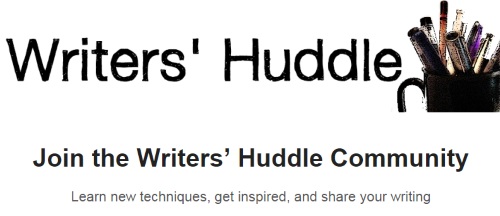
(From Writers’ Huddle.)
At the start of 2012, I launched my first fully-fledged membership site, Writers’ Huddle, a community / teaching site for writers. Of everything I’ve created, this has been one of my absolute favourites. It’s been great to get to see members flourish and succeed in their writing goals, and (on a rather more mercenary note), I’ve enjoyed having some regular monthly income.
If you’ve not come across the idea of membership sites before, they’re simply sites where people pay a monthly fee for as long as they want to remain members. Of course, you can use the same software to deliver something a bit different (e.g. a course with a one-off membership fee, or a course that people pay for over several months).
I’d definitely recommend joining at least one membership site before launching your own, so you can figure out what works well and what could be tweaked. I was a member of Copyblogger’s Third Tribe for a couple of years (their new membership site is Authority) and I’ve also been in Michael Hyatt’s Platform University.
You’ll want to think about:
What content will you be providing on a monthly basis? I offer video or audio seminars, with an edited transcript plus a worksheet, and occasionally add in extras like “Challenges” (run through the forums) and ecourses of varying lengths.
How much will you charge each month? Keep in mind that committing to a monthly fee, even if there’s an option to cancel at any time, can be off-putting to potential customers. You want to keep the fee low enough that they won’t immediately cancel if they have a busy month or two and don’t manage to login. However, you’ll also need to consider how much time you’ll need to put in for each new member: e.g. helping them with any technical issues, responding to questions in your forums (if you have them) and so on.
Whether you’ll be permanently open for new members, or whether you’ll only open up at certain times of year. Either approach could be successful: I’ve tried both with Writers’ Huddle, and right now, my feeling is that opening up periodically is better than taking new members at any time. (It cuts down on admin, and makes it easier to launch new courses etc … plus having a deadline gets people to make up their minds about joining!)
How Much Do Membership Sites Make?
This obviously depends on (a) what you charge per member and (b) how many members you have. You might decide to create a small, exclusive site with a limit of 20 members … but if you’re charging $199/month per member, you’d make almost $4,000 per month. Right now, I charge $19.99 per member for Writers’ Huddle.
I’d suggest launching at a slightly lower price than the one you plan to stick with, so that trail-blazing early members can get locked in at a great rate for as long as they stick around. This lets you get a good core of members to begin with, which is a big help if you’ve got forums or other interactive elements. It also allows you to get feedback and improve your site before raising the price.
Learn More:
7 Tips for Creating and Running Your First Membership Site, Ali Luke, Copyblogger – key tips I’ve learnt from running Writers’ Huddle
The Insider’s Guide to Running a Six-Figure Membership Site from Home, John Yeoman, SmartBlogger – lots of detail on both the “why” and the “how” of running a membership site. John has a lot of detailed figures which will be really useful once you’re up and running with your site and want to work out how to attract new members in a cost-effective way.
Digital Access Pass – this is the software I use to run Writers’ Huddle, and I’ve been pretty happy with it.
Whew!
I’m hoping this has given you a clearer idea of how I actually make money from my writing, and I also hope I’ve inspired you to try out some entrepreneurial routes yourself.
Get the Printable Workbook Version of This Post
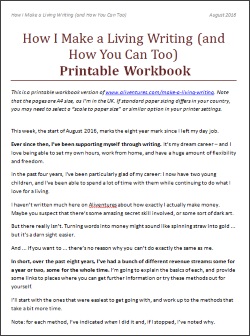 Just pop in your email address below to get this post as a printer-friendly workbook (with questions to get you thinking about each method of making money as an online writer, plus space to write notes).
Just pop in your email address below to get this post as a printer-friendly workbook (with questions to get you thinking about each method of making money as an online writer, plus space to write notes).
You’ll also get access to my free mini-ebooks, including “Time to Write” and “The Two-Year Novel”, and you’ll receive tips and advice on writing once a week, by email. Of course you can unsubscribe at any time.


This is an excellent post, Ali! Thank you for sharing this.A lot of the times when I find articles like this, it’s hard to relate to or implement in my own structure, but this was perfect and exactly what I needed. Thank you for the help! 😀 Love you writing.
Nikki’s last blog post ..Custom Letterhead Contest Winner!
Thanks Nikki! Glad this helped — if there’s any area you’d like me to expand on, just let me know. 🙂
hello !
i was just wondering how you got your job for daily writing tips. i’ve visited the site, but i haven’t really seen if they’re looking to “hire” new contributors. i would very much like to write articles, not for the money, but to get experience in writing and share my ideas, and it would also be very good for my cv. could you please give me some information?
thank you very much!! have a wonderful day
That job was back in 2008 (I’m not a paid writer there any longer, though I do write occasional guest posts for them). As far as I’m aware, Daily Writing Tips currently has a full complement of staff!
I got the job in the first place by sending in a guest post — the editor happened to be looking for writers.
If you’re interested in writing just for the experience, rather than for money, you could try guest posting for sites like Daily Writing Tips. Good luck!
All your money-making secrets revealed at last!
Just Kidding…your passion for writing shows, and I guess that’s also necessary. When you first started was your goal to make a living solely from blogging? or did you just do it for the love of writing?
Also, you mentioned that you write fast…is this just natural for you? Any tips?
Thanks Ali, great post!
Zac’s last blog post ..A New Direction For Turning Point Motivation Blog, Plus Bonus Preview Links!
Haha!
I naturally write fast. (I also talk fast!) It helps that I can touch-type… I’m limited by my thinking speed rather than my typing speed. 😉
And as to how I do it … How to Write Thousands of Words Every Single Week
thank you very much Ali! good luck
Ali,
I always considered you to be a gypsy girl, gazing into a crystal ball, and yelling…abracadabra…ah, an occult artist and the dark arts. You, the female version of Darth Vader. These thoughts did cross my mind, but now I know better. (By the way, I’m just pulling your leg…don’t take it in the wrong way…I have a weird sense of humour.) Otherwise, how could you be so prolific? I would open any darn website–poof–Ali would be there.
On a more serious note, however, thanks for the autopsy report. Now, finally, we know just how you do it. Nobody does it better, Ali, not even James Bond. It’s time for 007 to start searching for another job. There’s a new gal in town and she’s armed with a license to kill. Truly, the pen is mighter than the sword–or the Walther PPK.
Cheers.
Hahah! And thanks! I think that’s the first time I’ve ever been compared to James Bond 😉
“Turning words into money might sound like spinning straw into gold.” Save this sentence for your next book–it is terrific and explains the problem perfectly.
Ali, you take my breath away that you figured all this out and made it work. I’m in awe…and overwhelm at the same instant.
Mary E. Ulrich’s last blog post ..HUD tips for People with Disabilities| Part 3
I think I may have used that sentence before (can’t actually remember where now!)
And thank you! I probably made the whole process sound a bit neater than it really was … I bumbled into paid blogging by accident, and it took over a year of writing before I made much money from advertising income. But I’m very pleased with what I’ve managed so far, and I’ve certainly learnt from my mistakes as well as my successes!
Excellent post Ali and ever so informative. I learned a lot – especially about the marketing of ebooks. I did an ebook a year ago and to date have not made one single sale. Very discouraging as I spent 8 years writing the book. It’s all about my personal experience w/personal development and midlife. Informative and yet funny at the same time. I have had excerpts from it published in magazines and people who read pieces from it love it, but no sales. Can’t figure this out. I even have a free excerpt on my blog site. Any suggestions??
Alison Elliot’s last blog post ..The Lazy Daze of Summer Reading – What’s In Your Basket?
Cheers, Alison! 🙂
Sorry to hear about your ebook – how frustrating 🙁 I wonder whether there’s a clear “why to read this” for the reader? I find that it’s much easier to sell something that’s business-related than something that’s mainly entertaining/enlightening.
Do you have a sales page for the book? Or are you just using the free sample to market it? I found this page – http://lifebydesignwithalison.com/product/ebook-free-chapter/ – on your site, but I couldn’t find anything that explained what the book was, gave testimonials, told me why I should read it, etc…
that was a very interesting read for me Ali
of course i know about the advertising thing because i advertise at your blog 😀 but the other sources are new to me
keep it up :))
Haha! Glad you enjoyed it, thanks Farouk 🙂 And thank you for your continuing support of the blog, too!
I was blown away at all the information you were willing to share on this blog! I had to bookmark this page so that I could come back to it again and again. Thanks so much!
Cheers Cygnet! Glad to help! 🙂
Thanks Ali for being so transparent about your income sources. So many bloggers and writers give general ideas of what you should do but without any how-to resources or actual numbers.
Your are an excellent writer (no need to mention that of course 😉 ) and your writer’s income only proves this point. I found several very helpful resources in this article that I haven’t seen before. I am currently working on my first ecourse/ebook (a mix of both) and hopefully by mid fall I will have some monetary results.
Thanks for the inspiration and the experience that you share on this blog and all over the web 🙂
Anastasiya’s last blog post ..How to Ignite a Spiritual Spark in Your Romance
Thanks Anastasiya, and hey, my writer’s ego always appreciates a boost 😉
Good luck with your ecourse/ebook, sounds like a great project! If there’s anything specific you’d like me to write about here on Aliventures (or even as a guest post on ProBlogger or similar) just let me know. 🙂
Thanks so much for sharing your income strategies, Ali. I think you are far too qualified as a writer and a coach and a teacher and I was surprised to see your hourly-rate to be so reasonable. It’s a steal and I’d recommend anyone that I know to work with you in a heartbeat and it’s great to know you enjoy the coaching too. I hope it’s ok to send you referrals. Hope you are doing marvelously in all other fronts too!
Farnoosh’s last blog post ..Gary Vaynerchuck Spells it Out in Thank you Economy
Thanks, Farnoosh! It’s more than okay to send me referrals, it’s positively encouraged. 😉 By all means, point people my way!
Ali, this is a really encouraging & resourceful post. As a beginning blogger (long-term traveler) I have an enormous amount of resources to share in terms of my photos and youtube videos. My goal is to monetize my blog and I will start pursuing some of the diverse streams of revenue you’ve suggested in this post. I’m definitely bookmarking this! 🙂
Nomadic Samuel’s last blog post ..Boy & Buddhist Monks | Almsgiving, Laos | Travel Photo
Cheers Samuel! Glad this one helped — and good luck with your monetization. Just let me know if you’d like me to write more about any of these particular revenue streams. 🙂
I’ve been wondering about how one starts in some of these revenue sources. Thanks for sharing your resources. I’m going to have to bookmark this post so I can keep coming back to it!
Thanks Ann, glad it was useful! 🙂
Hi Ali! Thank you for another wonderful post =) You don’t know how much this post has inspired me today. You see, I left my regular job just recently, 1 month as of today to be exact =) Most of my officemates thought that I was crazy to leave everything, but writing has always been my passion and I know I just have to believe in myself. This post made me realize even more that following your passion could be both fulfilling and sustaining. I’m still at the starting line of my writing career but I know I can make it as long as I never lose faith in myself. Plus, there are people like you who are always there to give advices and inspiration. Thank you =)
Wow — good luck, Shyxter! You absolutely can do it … there might be some ups and downs, but stick it out, and you’ll get there. I’ve got no regrets that I quit my office job three years ago. 🙂
Ali, this is a brilliant blog, THANK YOU!
I came across you today via your guest post on Write to Done and I’m hooked! I’ve been writing my blog very part time for about a year around my job and 3 children! You inspire me to keep going and tell my story.
Best
Rebecca
ps weirdly the wonderful lady who took your photos lives not 2 miles away from me – serendipity!
Rebecca’s last blog post ..Summer Holidays and a 13 year old boy
Cheers, Rebecca! And good luck with your own blog (and the summer holidays…!) I love your blog’s title, by the way… 🙂
I lived in London until a year ago, which is how I know Antonina!
Hi Ali,
I’ve only been reading your blog and email newsletter a short time now, but I LOVE LOVE LOVE it! Finally, a blog about my secret passion (writing) that feels REAL, down to earth, and is actually more helpful than I could have hoped! I’m so glad I found you! Thanks so much!
Juliana Deen’s last blog post ..Free Pattern for the Fourth of July
Thanks Juliana! So glad you’re enjoying the blog and newsletter – and if there’s anything extra-helpful I can write about, just let me know. 🙂
Hi Ali,
Great post! Thanks for sharing the specifics of how you make it happen…the details are just what I need as I get my blogging start.
Thanks for sharing…looking forward to future posts! -Faun
Ali, you rock! You work so freakin’ hard and I just admire the heck outta you for making all this happen
🙂
Shauna’s last blog post ..The Amazing Adventures of Svava – Part II
Ah, cheers Shauna! 🙂 I probably make it sound easier than it is (there have definitely been a few wrong turns!) … but I really enjoy what I do, and that’s worth all the work!
What a brilliant post- an inside look at a writer’s multiple streams of income. My experience is the reverse of your story- I started out coaching with creatives and now I’m starting to make money with writing and blogging. Like your site, I’ll be adding ebooks and product packages so I’m coming to you for inspiration and direction …and will be buying your ebooks!
Cheers, Brad, and best of luck with your writing and blogging! Hope you enjoy the ebooks … 🙂
Ali
I love what i have read. I have been looking for something like this for a long time. I have a passion for writing and not necessarily for money but to gain an experience in that field. I have got tactics and am very much delighted to find this article.
Thansk Lyd – glad it was helpful! 🙂
You have a ton of great information here. Great post!
Victoria’s last blog post ..Activities For Stay At Home Moms
This is a REALLY good post. I have been writing for money almost two years, but haven’t had the courage to go at 100% full time. I would basically sell one of my ebooks and write SEO articles. What I have found when it comes to pricing your services as a writer, is that it is better to write for blog owners who have a subscription list and/or reader base. This way, they would be more interested in the quality of the content rather than quantity. Website owners looking for SEO articles, usually are desperate for traffic to their site, and they are often very flaky and low-ballers.
My question to you is, how do you establish a LONG TERM relationship with clients. I would find it more enjoyable to write if the work was long-term and I didn’t have to keep advertising. Some writers say they use a writer’s contract or agreement. How do I present this to potential clients without scaring them off? Thank you advance to anyone who can answer this question 😉
Thanks, Williams, glad this was useful. 🙂 I agree that it’s good to write for quality blogs rather than producing SEO articles.
I’ve never presented a client with an up-front contract/agreement, so I’m not sure how best you’d do that without scaring people off! What I do is look for clients who are likely to want regular, long-term content — blogs are ideal. I’m still a regular writer for two big blogs that I started writing for in summer 2008…
Thanx Ali,
I left my day job few months ago and am still struggling…
Hope things will start working out soon.
Interesting advice. I especially like the breakdown of prices. very helpful.
Nikki,
I am very encouraged and I thought I just say thank you. I am new in blogging and from your content I have already got quite a few ideas that I could implement in my local market. I write for my blog. i did not think I could offer the same service to a Corporate. Its wonderful news.
irene’s last blog post ..To Lose Weight in Kenya is my New Year Resolution
Wonderful post, Ali! Yes, making time for writing is quite difficult, especially when we have to answer comments, emails, network and take care of the back end. You are doing a great job. Congrats.
Daniela Caride – Taildom’s last blog post ..The best pet odor enzymatic cleaners
Hi Ali,
I love you website, and this article is such a treasure! I bookmarked it and keep coming back to it. I’ve been getting paid writing for blogs and slowly getting into affiliate marketing, but you’ve given me so many other great ideas to add to it 🙂
Thanks for taking the time to share and help others!
Yulia
Yulia’s last blog post ..Ten Useful Online Resources for Writers
Ali,
Thank you for sharing your money-making secrets. My main source of income is writing for various blogs. I will say that most bloggers I know charge $0.10 per word or more. These other sources of revenue sound like excellent opportunities for writers as well. I personally don’t think I’d have it in me to run a full fledged membership site, so props to you and anyone else who chooses to launch one!
Alicia Rades’s last blog post ..I Turned Down a Good $1,000 in Blogging Gigs and Feel So Much Better
Thanks for commenting, Alicia! I’ve dithered over different pricing models — most of the blog posts I write are on topics I know well, or where someone else is doing the initial research, so my time spent per word isn’t too high. 🙂
Out of the many things I’ve done over the past six years, Writers’ Huddle is definitely one of my favourite projects. Yes, a full membership site takes a fair bit of work (especially at the set-up stages) but it’s been really rewarding — and a huge privilege — to watch a community of writers come together.
A lot of bloggers often talk about multiple income streams but they don’t actually explain where the money comes from, so I’m glad you’ve done so here. It really has demystified the process somewhat, and made it a lot more daunting! The only questions now are around where to find the opportunities but I suppose that is for each writer to work out. (I have other questions about tax and so on but that’s just dull)
Icy Sedgwick’s last blog post ..Get Suspended in Dusk for FREE until Halloween
Thanks Icy! 🙂 So glad this was helpful — and if you want further information on any of these, do ask. I’m afraid I’ve nothing useful to say about tax (I get Paul, my husband, to sort out my accounts for me…)
I love the fact I commented first in 2014 and now here I am, finally about to launch myself into the world of paid writing (I hope!)
I meant what I said on Facebook too, you are a real inspiration! I’ve heard Joanna Penn talking about having online mentors and I’ve always thought of you as one of mine!
Icy Sedgwick’s last blog post ..3 weird things you might find at a crossroads
Aw, thank you! I’m really touched. 🙂 I’ve had a ton of online mentors over the years (Joanna amongst them) … I never really think of myself that way, though, more like someone who might just be a step further along a particular path.
(For what it’s worth, I’m inspired by / envious of your ability to focus on writing and publishing fiction..!)
Actually terrific article great perform i like your job. Many thanks. Stay sharing.
Nice post Ali. 🙂
I once earned money contributing short articles for Readers Digest and other small magazine around 3-4 years ago and I find it a great side job or source of income as well – specially for working moms. And one of my friend actually does the same by sending quotes to be placed on those hallmark cards.
It wouldn’t be a fixed income though, but if your articles or contents are great, you’ll surely earn from them.
They say writing is not for everyone, but it doesn’t mean you can’t make money with the that you wrote only. You can actually serve as a source for all the great article by reposting or sharing them in your Facebook page or any social media site or page you own.
This way people can have a one stop shop for all the articles they wanted in a certain niche that you provide.
My goodness my goodness my goodness! You have given a lot of very good information and I can’t wait to click on your links and read those. Thank you very much for this post. I hope you are enjoying your time with your new baby. Congratulations!
Hi Ali,
What an amazing post! There are actually several posts in this and I will probably return again to try and absorb some more information.
Thank you and congratulations on the new baby x
This is very informative and very handy now that I am seriously considering trying out writing though on part time basis. Thanks for sharing this great tips.
Glad this was helpful, Chidi — and best of luck with your writing!
I am looking to be employed being a writer in the very near future.
Please get back to me as soon as possible.
Thank you for your time.
I am looking to be employed as a writer online in the near future.
I do have a few story overview that need to be completed.
Please get back to me as soon as possible.
Thank you for your time.
Best of luck, Elizabeth!
I’m afraid I can’t offer any individual help and support (due to an overwhelming number of current commitments — mainly my two very small children) but do feel free to keep browsing Aliventures for more posts on freelancing.
I love this post, really thinking about giving this a go. Question by the way, are you British by chance?
I am! Well spotted. 🙂 I was born in Cambridge, and have since then lived in Oxford, Cambridge again, London, and now Leeds.
This post was really insightful! I’m just getting started on this and a lot of the other articles just talk about how to make more revenue, but this helps me look for places to start!
Glad to help, Rebecca — and best of luck on your path to making a living writing. 🙂
This is awesome! Thanks for sharing! I’m a fairly new blogger and am still learning. Even though blogging is a lot harder than I anticipated, it has been one of the most fulfilling things I’ve done. I hope to one day follow your footsteps!
Shiva mantra’s last blog post ..Lord Shiva Mantra: Find Story, Birth, Five Mantras, How to Worship Lord Shiva | भगवान शिव के मंत्र
There’s so much to learn in the early days of blogging — I promise it gets easier! Glad you’re enjoying the journey. 🙂
Thank you for helping
This post is so full of helpful information! Making a living from writing is the dream! Thank you so much for sharing what you do and all the resources you gave are fantastic!
I totally agree! For the past few years now, writing has been paying my bills, house rental and other expenses. I am so blessed that God gave me this writing talent.
I would like to became a writer how do i get request from a client…?
how can I get request from a client whom need an article written by me…?
That’s a very big question to answer! I’d suggest checking out Carol Tice’s site Make a Living Writing, which has tons of information about finding clients and much more.
Thanks for the wonderful information. I am also writing contents,blogs on Redgage for the last one year and getting regular income on the basis of the size of the content. In content writing, the most important thing which matters is your grip on the language and the quality of your content. If you have both these qualities then you will be certainly successful in your efforts to make money online. If you will visit here https://www.linkedin.com/company/redgage-llc yours remaining doubts on the subject will be over.
This post was very informative. Thanks for sharing.
Thanks for sharing.I have learnt alot .I am also interested in this can i get yuor help please
Frank and Emmah, glad you both found it helpful!
Emmah, I’m afraid due to my current workload, I can’t offer individual help and support — if you’ve got a topic or question you’d like me to cover on the blog or newsletter, though, do drop me a line at ali@aliventures.com.
iF you want to make money by writing Online, you need to brush up on your writing skills. It’s one of the most central factors to making good money. Set aside some time every day to practice your writing and get yourself a copy of Strunk and White and study it. Reading well-written books by contemporary authors is a great way to learn the difference between good writing and bad writing.
I’ve been making a living from writing online for about 18 months now, and it’s a dream come true. I always wrote, but never for pay, until I lost my job unexpectedly and was out in Asia with no other real options. I found online writing just on time and man, it’s the best thing that ever happened 🙂 Thanks for this post, and for those who are doubting, it really is possible!
Congrats to you! Online writing is one of the best things that’s happened to me too. 🙂
This is a really great write up. Thanks so much for the mention! Can’t believe I missed it when the post first came out!
Ramsay
Ramsay’s last blog post ..What Will You Sell if You Give Away Your Best Blog Content for Free?
Thanks, Ramsay! 🙂
So enjoying your articles, Ali, thank you for sharing your insights!
I’m a ghostwriter in New York, US.